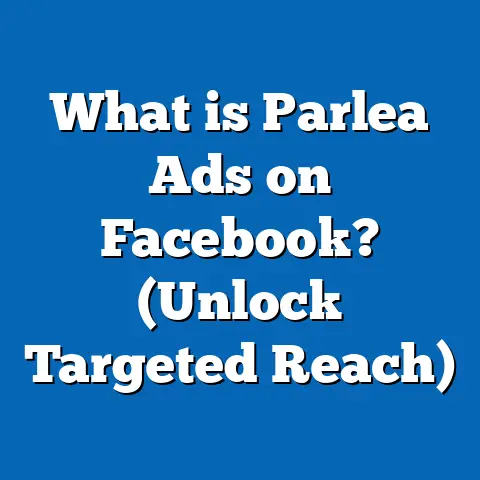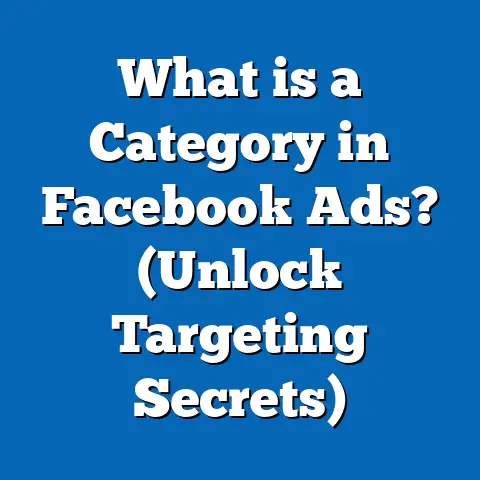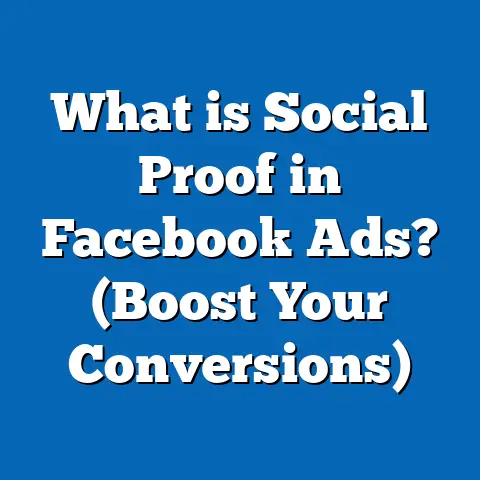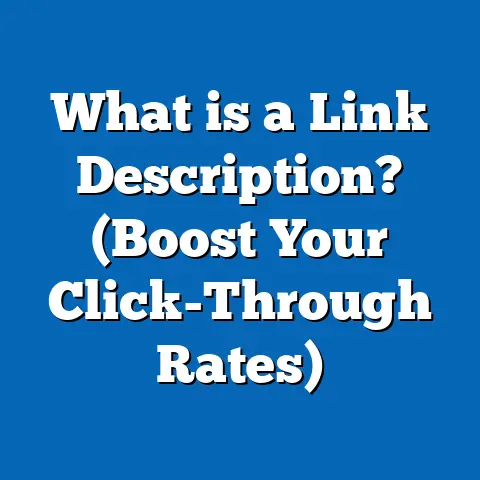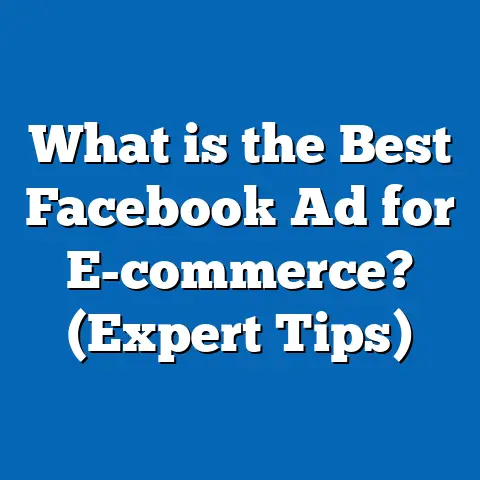What is a Good CTR for Facebook Ads? (Boost Your Reach!)
What is a Good CTR for Facebook Ads? (Boost Your Reach!)
Introduction: Transforming Your Facebook Ad Performance
Imagine transforming your Facebook ad campaigns from mediocre to highly effective — reaching your ideal customers, engaging them meaningfully, and boosting your sales dramatically. This transformation pivots on mastering one key metric: Click-Through Rate (CTR). CTR is not just a performance number; it serves as a pulse check on how well your ads connect with your audience and how efficiently your advertising budget is being spent. Understanding and optimizing CTR will help you unlock Facebook’s advertising potential by increasing reach, improving relevance, and maximizing return on investment (ROI).
Understanding CTR: The Heartbeat of Facebook Ads
What is CTR?
CTR — or Click-Through Rate — measures the ratio of users who click on your ad after seeing it. It’s a straightforward metric but incredibly insightful: CTR=(Number of ClicksNumber of Impressions)×100\text{CTR} = \left(\frac{\text{Number of Clicks}}{\text{Number of Impressions}}\right) \times 100
If 1,000 people see your ad (impressions) and 50 click it, your CTR is 5%.
Why Is CTR Important for Facebook Ads?
CTR is a critical measure because it reflects:
- Ad Relevance: A higher CTR signals that your ad content resonates with users.
- Cost Efficiency: Facebook rewards relevant ads with lower costs per click (CPC), meaning you get more clicks for less money.
- Audience Engagement: It measures how compelling your offer and creative are to the audience.
- Campaign Health: CTR helps identify if your ads need creative or targeting adjustments.
- Algorithm Impact: Facebook’s machine learning uses CTR to rank ads, determining which get more visibility.
Think of CTR as the bridge between impressions and actions — without clicks, your ads won’t drive traffic or conversions.
Different Types of Clicks Measured
Facebook tracks multiple click types:
- Link Clicks: Users click a link that leads outside Facebook (e.g., website).
- Post Clicks: Any click on the ad (including likes, comments).
- Landing Page Views: Clicks that actually lead to page load.
For most advertisers looking to increase traffic or sales, Link Clicks CTR is the key metric.
What is a Good CTR for Facebook Ads? Data-Backed Benchmarks
Industry Average CTRs on Facebook
Facebook advertising effectiveness varies widely by industry due to different audience behaviors and ad types. Here’s an updated breakdown based on aggregated data from WordStream, AdEspresso, and other industry sources (2023-2024):
| Industry | Average CTR (%) | Notes |
|---|---|---|
| E-commerce | 1.66 | Strong visual appeal boosts engagement. |
| Apparel & Fashion | 1.24 | Highly competitive but allows creativity. |
| Finance & Insurance | 0.56 | Sensitive topics often see lower engagement. |
| Health & Fitness | 1.01 | Growing interest in wellness ads. |
| B2B | 0.78 | Niche audience; lower volume but valuable clicks. |
| Technology | 1.04 | Product demos and benefits drive clicks. |
| Real Estate | 0.99 | Local targeting critical to success. |
What Constitutes a Good CTR?
- Below 0.5%: Indicates poor targeting or irrelevant creative.
- 0.5% – 1.5%: Average; many campaigns fall here.
- 1.5% – 3%: Good; shows strong audience connection.
- Above 3%: Excellent; indicates highly compelling ads or very narrow targeting.
An average Facebook CTR across all industries typically ranges between 0.9% and 1.6%, but aiming for above 1.5% is a practical goal for most advertisers.
Research Insight: How CTR Relates to ROI
A study by WordStream found that campaigns with a CTR above 2% tend to have significantly better ROI due to:
- Lower CPC (Cost Per Click).
- Higher Quality Scores from Facebook.
- Increased conversion rates driven by better audience alignment.
Case Study: Apparel Brand Boosting Their CTR from 0.8% to 2.3%
A mid-sized apparel company worked with these steps:
- Refined Targeting: Narrowed focus on women aged 25–34 interested in fitness fashion.
- Creative Overhaul: Shifted from generic product shots to lifestyle images showing real people.
- Strong CTA: Added “Shop Now” buttons aligned with seasonal offers.
Result: A two-month campaign saw CTR increase from 0.8% to 2.3%, leading to a 40% lift in sales attributed directly to Facebook ads.
Factors Influencing Facebook Ads CTR
Audience Targeting: The Foundation of High CTR
Effective targeting ensures your ads are seen by people likely to care.
- Custom Audiences: Retarget website visitors or email subscribers for warm leads.
- Lookalike Audiences: Find new people similar to existing customers.
- Demographic Layering: Age, gender, location combined with interests.
- Behavioral Targeting: Purchase behavior, device usage.
Poor targeting leads to low engagement and wasted budget.
Ad Creative Quality: Capture Attention Instantly
Facebook users scroll quickly; your ad must stand out.
- Use crisp, high-resolution images or videos.
- Avoid cluttered visuals; focus on one strong message.
- Incorporate brand colors and logos consistently.
- Personalize visuals based on audience preferences.
Copywriting That Converts
Ad copy should be:
- Clear and concise.
- Benefit-focused rather than feature-heavy.
- Incorporate emotional triggers like urgency or exclusivity.
- Use simple language with a strong call-to-action (CTA).
Example: “Get Your Summer Look Today – Limited Stock!”
Placement Impact on CTR
Facebook offers multiple placements:
- Feed Ads: Highest visibility and usually best CTR.
- Stories: Vertical format; good for immersive visuals.
- Marketplace: Great for local offers.
- Right Column: Lower engagement; often less effective.
Placement affects both visibility and user interaction patterns.
Campaign Objective and Ad Format
Your campaign goal impacts what type of engagement you get:
- Traffic campaigns focus on link clicks.
- Engagement campaigns focus on likes/comments/shares.
- Video ads generate high engagement but may have lower link click CTR.
Choose your objective wisely based on what matters most.
How to Improve Your Facebook Ads CTR: Detailed Strategies
1. Refine Your Targeting Continuously
Targeting should never be static:
- Use data from your Pixel and Facebook Analytics.
- Exclude audiences who have already converted.
- Create segmented Custom Audiences for personalized messaging.
Example: For a fitness brand, create separate audiences for beginners vs advanced users and tailor ads accordingly.
2. Conduct Rigorous A/B Testing of Creatives
Test multiple variations including:
- Images vs videos.
- Different headlines and CTAs.
- Ad copy length variations (short vs long).
Data shows video ads can boost engagement by up to 30%, but sometimes static images outperform depending on context.
3. Write Copy That Speaks to Your Audience
Tips for compelling copy:
- Start with a question or bold statement.
- Highlight key benefits upfront.
- Incorporate social proof (“Join 10,000 happy customers”).
- Include urgency (“Offer ends soon”).
4. Use Clear & Relevant Call-to-Actions (CTAs)
Match CTAs with objectives:
- “Shop Now” for e-commerce sales.
- “Learn More” for awareness campaigns.
- “Sign Up” for lead generation forms.
Avoid vague CTAs like “Click Here” that don’t tell users what to expect.
5. Optimize Ad Placements Based on Performance
Use Facebook’s reporting tools to see which placements have the highest CTR.
- Shift budget dynamically using Campaign Budget Optimization (CBO).
- Customize creatives for specific placements like Stories vs Feed.
Advanced Insights: The Role of Facebook’s Algorithm in CTR
How Relevance Score Connects to CTR
Facebook assigns a relevance score based primarily on expected engagement including CTR.
Higher relevance scores result in:
- Lower CPC.
- More impressions at the same budget.
Facebook favors ads with high predicted CTR in its auction system.
Managing Frequency & Avoiding Ad Fatigue
Frequency refers to how often the same user sees your ad.
High frequency (>3) can cause ad fatigue leading to declining CTR.
Strategies:
- Rotate creatives every 1–2 weeks.
- Limit frequency with frequency caps if needed.
Regularly refreshing ads keeps them feeling new and engaging.
Balancing CTR vs Conversion Rates
CTR measures clicks but doesn’t guarantee conversions.
Common scenarios:
- High CTR + Low Conversion = Landing page issues or misleading ad promises.
- Low CTR + High Conversion = Highly targeted but niche audience.
Aim for a balance by optimizing both ad engagement and post-click experience.
Comparing Facebook Ads CTR with Other Platforms
Understanding how Facebook’s CTR stacks up can inform cross-channel strategies:
| Platform | Average CTR (%) | Insights |
|---|---|---|
| 0.9 – 1.6 | Deep targeting options; visual-heavy content. | |
| Google Search | 3 – 5+ | Intent-based searches yield higher CTRs. |
| ~0.8 – 1.2 | Younger demographics; visual-first platform. | |
| ~0.4 – 0.7 | B2B focus; smaller but high-value audience. | |
| ~1 – 3 | Real-time news & trends; high engagement ads. |
Facebook offers excellent targeting depth but generally has lower average CTR than Google Search due to user intent differences.
Practical Examples & Real World Applications
Example #1: Local Restaurant Boosting Lunch Orders
Objective:
Drive online lunch orders through delivery apps.
Approach:
Targeted local radius around restaurant with appetizing photos and “Order Now” CTA buttons timed around lunch hours.
Results:
CTR jumped from 0.9% to 2.2%, doubling orders during campaign period.
Example #2: SaaS Company Generating Leads
Objective:
Increase signups for free trial of project management software.
Approach:
Used explainer videos targeting small business owners with “Start Free Trial” CTA.
Results:
Consistent CTR near 1%; lead conversion rate of 15%, surpassing industry averages.
Example #3: Nonprofit Awareness Campaign
Objective:
Increase awareness about environmental conservation programs.
Approach:
Emotional storytelling video ads targeted at environmentally conscious adults aged 30–50.
Results:
CTR of ~1.8%, plus significant increases in website visits and newsletter signups.
Common Mistakes That Kill Your Facebook Ads’ CTR
- Broad Targeting Without Focus
- Wastes impressions on uninterested users.
- Weak or Irrelevant Creative
- Blends into feed; fails to capture attention.
- Poor Copywriting
- Confusing messages or no clear benefit stated.
- Ignoring Mobile Optimization
- Majority of Facebook users are mobile; bad mobile experience lowers engagement.
- Not Testing Enough
- Sticking to one ad variant misses opportunities for improvement.
Tools and Techniques to Monitor and Improve CTR
Use Facebook Ads Manager Analytics
Track metrics such as:
- Link Clicks
- Impressions
- Frequency
- CPC
- Relevance Score / Quality Ranking
Analyze trends over time by audience segment and placement.
Leverage Heatmaps & User Behavior Tools
Understand post-click behavior using tools like Hotjar or Google Analytics to identify landing page issues that might affect conversions after clicks.
Implement Dynamic Creative Testing
Facebook’s Dynamic Creative allows automated testing of multiple images, headlines, descriptions — speeding up optimization cycles.
Latest Trends Affecting Facebook Ads CTR (2024 Update)
Increased Use of AI-Powered Creative Tools
Advertisers are using AI tools like ChatGPT and Canva’s AI features to generate engaging copy and design faster iterations, boosting CTR through rapid testing and personalization.
Video Dominance Continues
Video ads now account for over 60% of total ad spend on Facebook, as they tend to generate higher engagement rates compared to static images.
Privacy Changes & Impact on Targeting
With Apple’s iOS updates limiting tracking, advertisers face challenges in precise targeting — making creative quality even more important for driving clicks organically within permitted audiences.
Integration with Instagram & Meta Audience Network
Cross-platform campaigns combining Instagram Stories and feeds with Facebook ads increase reach and provide data synergy — improving overall campaign CTR effectiveness through unified optimization strategies.
Summary: Boost Your Reach by Mastering Your Facebook Ads’ CTR
Understanding what constitutes a good CTR on Facebook ads is foundational for any marketer or business owner aiming to succeed in digital advertising today. While averages vary by industry, striving for a CTR above 1.5% is a practical benchmark indicating your ad content effectively engages the right audience.
Key takeaways:
- Optimize targeting continuously using Custom and Lookalike Audiences.
- Invest in high-quality visuals and compelling copy tested through A/B experiments.
- Match campaign objectives with appropriate placements and ad formats.
- Monitor frequency closely to avoid ad fatigue.
- Balance high CTR with conversion optimization via landing page improvements.
By focusing on these areas systematically, you can reduce wasted spend, increase meaningful engagement, and ultimately boost your reach on Facebook — turning impressions into clicks and clicks into customers.
Next Steps: Implementing What You’ve Learned
- Review your current campaigns’ CTR against industry benchmarks shared here.
- Develop a structured testing plan focusing on creatives, copy, targeting, and placements.
- Use analytics tools regularly to track performance metrics beyond just clicks.
- Refresh your creatives every few weeks to maintain audience interest.
- Consider integrating video into your ad strategy if not already doing so.
Mastering Facebook Ads’ CTR isn’t just about chasing numbers — it’s about building real connections with your audience that translate into business growth.
If you want me to create additional resources like spreadsheet templates for tracking your ad performance or detailed checklists for campaign audits, just ask!

